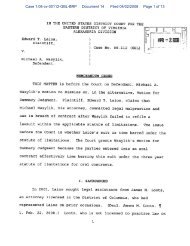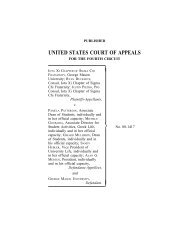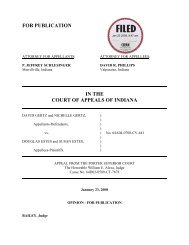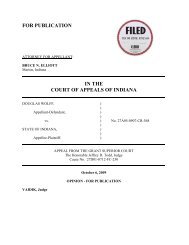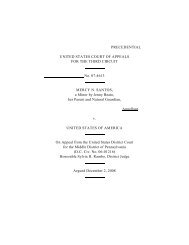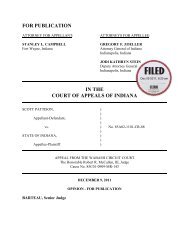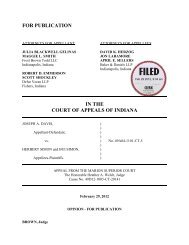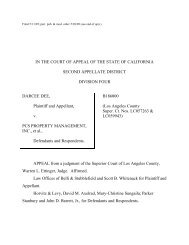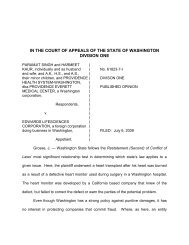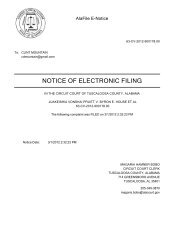Christina Margaret Porter, Deceased, by Brent M. Porter and Mary M ...
Christina Margaret Porter, Deceased, by Brent M. Porter and Mary M ...
Christina Margaret Porter, Deceased, by Brent M. Porter and Mary M ...
Create successful ePaper yourself
Turn your PDF publications into a flip-book with our unique Google optimized e-Paper software.
<strong>Porter</strong> v. Dartmouth CV-07-28-PB 09/30/09<br />
UNITED STATES DISTRICT COURT<br />
FOR THE DISTRICT OF NEW HAMPSHIRE<br />
<strong>Christina</strong> <strong>Margaret</strong> <strong>Porter</strong>,<br />
<strong>Deceased</strong>, <strong>by</strong> <strong>Brent</strong> M. <strong>Porter</strong><br />
<strong>and</strong> <strong>Mary</strong> M. Salstrom, as<br />
Administrators of her Estate<br />
<strong>and</strong> Individually<br />
v. Case No. 07-cv-28-PB<br />
Opinion No. 2009 DNH 145<br />
Dartmouth College <strong>and</strong><br />
John/Jane Doe Defendants 1-10<br />
MEMORANDUM AND ORDER<br />
<strong>Christina</strong> <strong>Porter</strong> died from injuries that she suffered while<br />
participating in an introductory ski class to fulfill her<br />
physical education requirement at Dartmouth College. <strong>Porter</strong>’s<br />
parents have sued Dartmouth College for negligence <strong>and</strong> wrongful<br />
death. Dartmouth has moved for summary judgment based upon an<br />
Equipment Rental <strong>and</strong> Liability Release Agreement(“Release<br />
Agreement”) that <strong>Porter</strong> signed prior to her accident, contending<br />
that the Release Agreement relieves Dartmouth College from any<br />
<strong>and</strong> all liability. I deny Dartmouth’s motion for summary<br />
judgment for the reasons set forth below.
I. BACKGROUND<br />
<strong>Porter</strong>, a Twenty-year-old undergraduate student at Dartmouth<br />
College (“Dartmouth”), enrolled in Dartmouth’s introductory ski<br />
class for the Spring 2004 semester to fulfill her physical<br />
education requirement. (Compl., Doc. No. 1, 13.) The ski<br />
class was conducted at the Dartmouth Skiway in Lyme, New<br />
Hampshire, a facility that is owned, operated, <strong>and</strong> maintained <strong>by</strong><br />
Dartmouth. (Id. 14.)<br />
A. The Accident<br />
On February 3, 2004, <strong>Porter</strong> was participating in the ski<br />
class at Dartmouth Skiway when her instructors allowed her to ski<br />
down a particular slope, apart from her classmates. <strong>Porter</strong><br />
obeyed their instructions <strong>and</strong> proceeded down the slope, without<br />
supervision, while the instructors accompanied the remainder of<br />
the class down a more difficult trail. (Compl., Doc. No. 1,<br />
18-22.) <strong>Porter</strong> skied off the trail on her way down the slope,<br />
resulting in catastrophic injuries that included multiple skull<br />
fractures, an arm fracture, <strong>and</strong> traumatic brain injury. (Id. <br />
28.) As a result of her injuries, <strong>Porter</strong> died on January 16,<br />
2005. (Id. 29-30.)<br />
-2-
<strong>Porter</strong>’s estate filed this action on February 2, 2007,<br />
asserting claims for negligence <strong>and</strong> wrongful death. On October<br />
24, 2007, I denied Dartmouth’s motion to dismiss <strong>and</strong> ruled that<br />
the New Hampshire ski area operator statute does not bar<br />
Plaintiffs’ claims. <strong>Porter</strong> ex. rel. <strong>Porter</strong> v. Dartmouth College,<br />
No. 07-cv-28-PB, 2007 WL 3124623 (D.N.H. Oct. 24, 2007).<br />
B. The Liability Release Agreement<br />
Dartmouth students who were enrolled in the Spring 2004 ski<br />
class were able to rent ski equipment, including skis, poles, <strong>and</strong><br />
boots. Approximately 80% of the students enrolled in the ski<br />
class rented ski equipment. (Def.’s Mot. for Summ. J., Doc. No.<br />
44-2, at 2.) Each student who rented equipment was required to<br />
complete <strong>and</strong> sign an Equipment Rental <strong>and</strong> Liability Release<br />
Agreement (“Release Agreement”) before receiving her equipment<br />
<strong>and</strong> participating in the ski class. (Id.)<br />
The Release Agreement is a one page form drafted <strong>by</strong> Solomon,<br />
the manufacturer of the bindings attached to the renting<br />
student’s skis. (Id.; Pls.’ Mem. of Law in Opp’n, Doc. No. 54-2,<br />
at 2.) The form is divided into three sections, each separately<br />
outlined <strong>by</strong> a black border. The first section, appearing at the<br />
top half of the page beneath the Solomon logo, asks the equipment<br />
-3-
enter to provide her contact information, as well as her height,<br />
weight, <strong>and</strong> age, to ensure that she receives the appropriate<br />
equipment sizes. (See Def.’s Mot. for Summ. J., Doc. No. 44-2,<br />
at 3.) This first section also asks the renter to classify her<br />
“Skier Type” <strong>by</strong> checking one of five available boxes in the upper<br />
right h<strong>and</strong> corner of the form. (See Pls.’ Mem. of Law in Opp’n<br />
App. Equipment Rental Agreement, Doc. No. 54-2, at A1.) The<br />
renter is provided with an informational chart to assist her in<br />
classifying her Skier Type according to her preferences for<br />
speed, terrain, <strong>and</strong> level of binding retention. (Id. at A2.) A<br />
signature line at the bottom of the section asks the renter to<br />
certify that the provided information is accurate, <strong>and</strong><br />
acknowledge that she will refrain from using the equipment until<br />
she fully underst<strong>and</strong>s its use <strong>and</strong> function. (Id. at A1.)<br />
<strong>Porter</strong>’s signature appears on the “Equipment User’s Signature”<br />
line on the Release Agreement submitted <strong>by</strong> the parties. (See<br />
id.)<br />
The second section of the Release Agreement, appearing<br />
beneath the renter’s signature line, allows the equipment<br />
technician to record the model <strong>and</strong> sizing specifications of the<br />
equipment, the price of the equipment, <strong>and</strong> the toe <strong>and</strong> heel<br />
-4
inding settings. An illegible signature appears on the<br />
“Technician’s Signature” line in the Release Agreement submitted<br />
<strong>by</strong> the parties. (See id.)<br />
The third <strong>and</strong> final section of the Release Agreement,<br />
occupying the lower half of the page, is comprised of seven<br />
paragraphs of text beneath the heading of “Equipment Rental &<br />
Liability Release Agreement,” followed <strong>by</strong> a signature line. (See<br />
id.; Def.’s Mot. for Summ. J., Doc. No. 44-2, at 3.) The first<br />
two paragraphs acknowledge that the equipment renter accepts the<br />
equipment “as is,” assumes financial responsibility for the<br />
equipment for the duration of the rental period, <strong>and</strong> underst<strong>and</strong>s<br />
that the binding system may not guarantee the renter’s safety.<br />
The fourth paragraph affirms that the renter underst<strong>and</strong>s that a<br />
helmet may further reduce the risk of injury. (See Pls.’ Mem. of<br />
Law in Opp’n App. Equipment Rental Agreement, Doc. No. 54-2, at<br />
A1.) At issue here are paragraphs three, five, <strong>and</strong> six of this<br />
third section, which state:<br />
[3] I underst<strong>and</strong> that the sports of skiing, snowboarding,<br />
snowshoeing, <strong>and</strong> other sports (collectively “RECREATIONAL<br />
SPORTS”) involve inherent <strong>and</strong> other risks of INJURY <strong>and</strong><br />
DEATH. I voluntarily agree to expressly assume all risks of<br />
injury or death that may result from these RECREATIONAL SNOW<br />
SPORTS, or which relate in any way to the use of this<br />
equipment.<br />
-5
[5] I AGREE TO RELEASE AND HOLD HARMLESS the equipment rental<br />
facility, its employees, affiliates, agents, officers,<br />
directors, <strong>and</strong> the equipment manufacturers <strong>and</strong> distributors<br />
<strong>and</strong> their successors in interest (collectively “PROVIDERS”),<br />
from all liability for injury, death, property loss <strong>and</strong><br />
damage which results from the equipment user’s participation<br />
in the RECREATIONAL SNOW SPORTS for which the equipment is<br />
provided, or which is related in any way to the use of this<br />
equipment, including all liability which results from<br />
NEGLIGENCE of PROVIDERS, or any other person or cause.<br />
[6] I further agree to defend <strong>and</strong> indemnify PROVIDERS for any<br />
loss or damage, including any that results from claims or<br />
lawsuits for personal injury, death, <strong>and</strong> property loss <strong>and</strong><br />
damage related in any way to the use of this equipment.<br />
(Id. (emphasis in original); Def.’s Mot. for Summ. J., Doc. No.<br />
44-2, at 3.) Dartmouth cites these paragraphs in its Motion for<br />
Summary Judgment, arguing that the Release Agreement, signed <strong>by</strong><br />
<strong>Porter</strong>, is a valid <strong>and</strong> enforceable exculpatory contract that<br />
relieves Dartmouth of any <strong>and</strong> all liability.<br />
II. STANDARD OF REVIEW<br />
Summary judgment is appropriate when “the discovery <strong>and</strong><br />
disclosure materials on file, <strong>and</strong> any affidavits show that there<br />
is no genuine issue as to any material fact <strong>and</strong> that the movant<br />
is entitled to judgment as a matter of law.” Fed. R. Civ. P.<br />
56(c). A party seeking summary judgment must first identify the<br />
absence of a genuine issue of material fact. Celotex Corp. v.<br />
-6-
Catrett, 477 U.S. 317, 323 (1986). The burden then shifts to the<br />
nonmoving party to “produce evidence on which a reasonable finder<br />
of fact, under the appropriate proof burden, could base a verdict<br />
for it; if that party cannot produce such evidence, the motion<br />
must be granted.” Ayala-Gerena v. Bristol Myers-Squibb Co., 95<br />
F.3d 86, 94 (1st Cir. 1996); see Celotex, 477 U.S. at 323.<br />
III. ANALYSIS<br />
New Hampshire law generally prohibits exculpatory contracts,<br />
including liability releases of the kind that <strong>Porter</strong> signed. See<br />
Barnes v. New Hampshire Karting Ass’n, 128 N.H. 102, 106-07<br />
(1986). Such contracts will be enforced, however, where (1) they<br />
do not violate public policy, (2) the plaintiff understood the<br />
import of the agreement or a reasonable person would have<br />
understood the import of the agreement, <strong>and</strong> (3) the plaintiff’s<br />
claims were within the contemplation of the parties when they<br />
executed the contract. Dean v. MacDonald, 147 N.H. 263, 266-67<br />
(2001) (quoting Barnes, 128 N.H. at 107).<br />
To determine whether a release meets prongs two <strong>and</strong> three of<br />
this three-part test, New Hampshire courts examine whether the<br />
release identifies with sufficient clarity the specific parties<br />
being released as well as the types of claims that the agreement<br />
-7-
covers. See Barnes, 128 N.H. at 107. A release’s terms are<br />
strictly construed against the defendant, who must show that the<br />
contract “clearly state[s] that the defendant is not responsible<br />
for the consequences of his negligence” <strong>and</strong> demonstrate that the<br />
plaintiff’s claims were “within the contemplation of the parties<br />
at the time of the execution of the agreement.” Id. A release<br />
agreement will be upheld only if its language “clearly <strong>and</strong><br />
specifically indicates the intent to release the defendant[] from<br />
liability for personal injury caused <strong>by</strong> the defendant[]’s<br />
negligence.” McGrath v. SNH Development, Inc., 158 N.H. 540, 545<br />
(2009) (emphasis added) (citing Dean 147 N.H. at 267).<br />
Dartmouth argues that the Release Agreement that <strong>Porter</strong><br />
signed when she rented her ski equipment bars <strong>Porter</strong>’s claims<br />
under New Hampshire law. Plaintiffs counter, however, that the<br />
release fails to state with sufficient clarity (1) that Dartmouth<br />
was a party to the contract <strong>and</strong> is therefore released from<br />
liability, <strong>and</strong> (2) that the release contemplated claims arising<br />
from Dartmouth’s educational ski class. 1<br />
1 Because I determine that the Release Agreement does not<br />
meet the exacting clarity st<strong>and</strong>ard outlined <strong>by</strong> the New Hampshire<br />
Supreme Court, I need not consider whether a special relationship<br />
existed between <strong>Porter</strong> <strong>and</strong> Dartmouth that renders the Release<br />
Agreement unenforceable as a matter of public policy. See<br />
Barnes, 128 N.H. at 107.<br />
-8
A. The Release Agreement Does Not State with Sufficient<br />
Clarity that Dartmouth Is a Party to the Contract<br />
An exculpatory contract need not specifically identify the<br />
defendant <strong>by</strong> name. See Dean, 147 N.H. at 270. However, the<br />
contract must at least provide a functional identification of the<br />
parties being released. See id. The Release Agreement that<br />
<strong>Porter</strong> signed neither specifically identifies Dartmouth <strong>by</strong> name<br />
nor functions to place the equipment renter on notice that she is<br />
relieving Dartmouth, <strong>and</strong> not merely Solomon, of liability. 2<br />
2 Dartmouth mistakenly relies upon Brush v. Jiminy Peak to<br />
support its position. 626 F. Supp. 2d 139 (D. Mass. 2009).<br />
While the facts in Brush bear some resemblance to those in the<br />
present case, the release signed <strong>by</strong> the plaintiff in that case<br />
st<strong>and</strong>s in marked contrast to the Release Agreement signed <strong>by</strong><br />
<strong>Porter</strong>. Brush, a student on the Middlebury College ski team,<br />
suffered severe injuries while participating in a collegiate ski<br />
race hosted <strong>by</strong> Williams College at Jiminy Peak. In that case,<br />
the court held that a United States Ski <strong>and</strong> Snowboard Association<br />
(USSA) release barred the plaintiff’s claims against her coach,<br />
race officials, <strong>and</strong> competing colleges. The court was careful to<br />
note, however, that the liability waiver “defined USSA quite<br />
expansively to encompass a host of individuals <strong>and</strong> groups<br />
including affiliates, volunteers, competition organizers,<br />
sponsors, coaches <strong>and</strong> representatives. It is clear that the list<br />
was meant to encompass anyone involved in running a competition<br />
sanctioned <strong>by</strong> the USSA.” Id. at 151. It was also “undisputed”<br />
that the plaintiff knew that the Williams-hosted event was<br />
sanctioned <strong>by</strong> the USSA, <strong>and</strong> that the liability waiver therefore<br />
applied. Id. The Release Agreement that <strong>Porter</strong> signed, on the<br />
other h<strong>and</strong>, includes no definition of “equipment rental facility”<br />
whatsoever. (See Pls.’ Mem. of Law in Opp’n App. Equipment Rental<br />
Agreement, Doc. No. 54-2, at A1.) <strong>Porter</strong> <strong>and</strong> her classmates, as<br />
novice skiers, would also have been less likely to underst<strong>and</strong> the<br />
import of a liability release agreement, in contrast to an<br />
-9-
The Release Agreement appears to be nothing more than a<br />
st<strong>and</strong>ard form agreement created <strong>by</strong> Solomon. The “Solomon” name<br />
<strong>and</strong> logo appear prominently in the upper left h<strong>and</strong> corner of the<br />
Release Agreement in large, capital letters, indicating that the<br />
form was clearly intended to release the equipment manufacturer,<br />
<strong>and</strong> not Dartmouth, from liability. Applying the Barnes st<strong>and</strong>ard<br />
to the form’s contents, neither <strong>Porter</strong> nor a reasonable person in<br />
<strong>Porter</strong>’s position would interpret the Release Agreement to be<br />
anything more than the st<strong>and</strong>ard equipment manufacturer liability<br />
release that all skiers are required to sign before rental<br />
equipment is issued, whether at a public ski resort or at<br />
Dartmouth Skiway. See Barnes, 128 N.H. at 107. The title<br />
“Equipment Rental & Liability Release Agreement” appears in bold,<br />
capital letters above the text of the Release Agreement’s<br />
substantive provisions, <strong>and</strong> the Release Agreement specifies that<br />
the recipient accepts the “equipment” as is, underst<strong>and</strong>s that the<br />
“binding system” cannot be guaranteed, <strong>and</strong> specifically releases<br />
the “equipment rental facility, its employees, owners,<br />
experienced ski team member like Brush.<br />
Furthermore, the court’s determination in Brush rested upon<br />
Colorado law, not New Hampshire law. There is no indication that<br />
even the release in Brush would relieve the defendants of<br />
liability under the exacting New Hampshire Barnes st<strong>and</strong>ard that<br />
must be applied here.<br />
-10-
affiliates, agents, officers, directors <strong>and</strong> the equipment<br />
manufacturers <strong>and</strong> distributors <strong>and</strong> their successors in interest<br />
(collectively ‘PROVIDERS’).” (Pls.’ Mem. of Law in Opp’n App.<br />
Equipment Rental Agreement, Doc. No. 54-2, at A1) (emphasis<br />
added). The term “equipment” appears thirteen times throughout<br />
the Release Agreement. (See id.; Pls.’ Reply Mem. of Law in<br />
Opp’n, Doc. No. 65, at 3.) This repeated emphasis on ski<br />
equipment, with no mention of Dartmouth College, its affiliates,<br />
or the Dartmouth Skiway facility, fails to place the equipment<br />
renter on even functional notice that Dartmouth was in any way a<br />
party to the Release Agreement.<br />
Dartmouth nevertheless argues that it <strong>and</strong> its employees are<br />
clearly released from liability because they qualify as<br />
“PROVIDERS” under the Release Agreement. See Def.’s Mot. for<br />
Summ. J., Doc. No. 44-2, at 11.) To be released from liability,<br />
Dartmouth must demonstrate that it is clearly a “PROVIDER[]” as<br />
that term is read within the context of the entire Release<br />
Agreement. See Wright v. Loon Mountain Recreation Corp., 140<br />
N.H. 166, 170 (1995) (holding that an exculpatory phrase did not<br />
relieve the defendant tour company of liability for a tour<br />
guide’s negligence when read within the context of the provisions<br />
in the preceding paragraphs).<br />
-11
The term “PROVIDERS” is defined in paragraph five of the<br />
Equipment Rental & Liability Release Agreement as “the equipment<br />
rental facility, its employees, owners, affiliates, agents,<br />
officers, directors, <strong>and</strong> the equipment manufacturers <strong>and</strong><br />
distributors <strong>and</strong> their successors in interest.” (Pls.’ Mem. of<br />
Law in Opp’n App. Equipment Rental Agreement, Doc. No. 54-2, at<br />
A1.) Dartmouth asserts in its Reply Memor<strong>and</strong>um that “there is no<br />
entity, other than Dartmouth, that can reasonably be considered<br />
the ‘equipment rental facility.’” (Def.’s Reply Mem. in Supp. of<br />
Mot. for Summ. J., Doc. No. 56, at 4.) However, Dartmouth<br />
provides absolutely no support for this proposition. Without<br />
such support, I cannot conclude that a reasonable person in<br />
<strong>Porter</strong>’s position would have understood that Dartmouth, rather<br />
than some other entity with whom Dartmouth had contracted, was<br />
the equipment rental facility.<br />
B. The Release Agreement Does Not Insulate Dartmouth from<br />
Liability for Claims Arising from Ski Instruction<br />
Even if Dartmouth was clearly <strong>and</strong> specifically identified <strong>by</strong><br />
name as a party to the Release Agreement, the Release Agreement<br />
does not apply to the type of negligence claims asserted here.<br />
New Hampshire law requires that a release call particular<br />
attention to the type of negligence claims that are being<br />
-12-
eleased. See Audley v. Melton, 138 N.H. 416, 419 (1994). In<br />
Audley, an exculpatory contract relieved a photographer <strong>and</strong> his<br />
studio “of any or all liability” associated with working with<br />
wild animals. Id. at 417. The New Hampshire Supreme Court held,<br />
however, that while the agreement insulated the defendant<br />
photographer from liability for injuries inflicted <strong>by</strong> wild<br />
animals, it failed to clearly state that the defendant was<br />
relieved of liability for the consequences of his own negligence.<br />
Id. at 419; McGrath, 158 N.H. at 547. Thus, the agreement did<br />
not release the photographer from liability for his failure to<br />
take any precautionary action when he noticed that the<br />
plaintiff’s hair was agitating a lion during a photo shoot. See<br />
Audley, 138 N.H. 416; see also Gonzalez v. Univ. Sys. of N.H.,<br />
No. 451217, 2005 Conn. Super. LEXIS 288, at *46 (Conn. Super. Ct.<br />
Jan. 28, 2005)(finding that a liability release agreement failed<br />
to release defendants, a state college <strong>and</strong> University System,<br />
from liability where the agreement could be interpreted as<br />
releasing cheerleading club members, other third parties, or the<br />
plaintiff herself).<br />
The language in the Release Agreement that <strong>Porter</strong> signed<br />
similarly fails to relieve Dartmouth of liability for the<br />
consequences of its ski instructors’ negligence. Although the<br />
-13
Release Agreement relieves “PROVIDERS” from “all liability for<br />
injury, death, property loss <strong>and</strong> damage which results from the<br />
equipment user’s participation in the RECREATIONAL SNOW SPORTS<br />
for which the equipment is provided,” the Release Agreement fails<br />
to call any particular attention to the notion of releasing<br />
“PROVIDERS” from liability for negligent ski instruction. (See<br />
Pls.’ Mem. of Law in Opp’n App. Equipment Rental Agreement, Doc.<br />
No. 54-2, at A1.) Nowhere in the Release Agreement do the words<br />
“instruction,” “lesson,” or “physical education” appear, nor does<br />
any other term extend the scope of the Release Agreement to the<br />
educational or instructional setting. The Release Agreement<br />
therefore fails to “clearly state” that Dartmouth is released<br />
from liability for negligence claims arising out of its<br />
educational ski class, <strong>and</strong> a reasonable person would not<br />
underst<strong>and</strong> the Release Agreement to relieve Dartmouth of<br />
liability in any educational or instructional context. See<br />
Barnes, 128 N.H. at 107. 3<br />
3 Dartmouth’s extensive reliance upon Checket v. Tuthill<br />
Corporation is misplaced. No. 99-1819, 2001 Pa. Dist. & Cnty.<br />
LEXIS 460 (Pa. County Ct. 2001), aff’d, 797 A.2d 368 (Pa. Super.<br />
Ct. 2002). Dartmouth attempts to draw parallels between the<br />
language in the Release Agreement that <strong>Porter</strong> signed <strong>and</strong> the<br />
language in the release upheld <strong>by</strong> the court in Checket to bolster<br />
its argument that the Release Agreement is both an equipment<br />
rental agreement <strong>and</strong> a liability release agreement. Even if the<br />
-14-
While the language of the release in Audley failed to<br />
relieve the defendant of liability because it was too general, a<br />
release’s language may also fail because it is too specific,<br />
i.e., where certain classes of claims are released against<br />
specific parties but the terms in the release fail to encompass<br />
the claims at issue. See Wright, 140 N.H. at 171. In Wright,<br />
the court concluded that a reasonable person might underst<strong>and</strong> an<br />
exculpatory clause’s language to relate to the inherent dangers<br />
of horseback riding <strong>and</strong> liability for injuries that occur for<br />
that reason, but not to harm that results from a tour guide’s<br />
failure to use reasonable care when h<strong>and</strong>ling his horse. McGrath,<br />
158 N.H. at 546 (citing Wright, 140 N.H. at 170). Here, a<br />
reasonable person would likely interpret the Release Agreement as<br />
limiting liability only with respect to claims that arise in the<br />
Release Agreement at issue here does release other parties from<br />
certain types of negligence claims, there is no clear indication<br />
that Dartmouth is such a party, that the agreement is intended to<br />
release negligent instruction claims, or that the Release<br />
Agreement extends beyond the recreational snow sports context to<br />
encompass negligence claims arising from educational ski<br />
instruction. Furthermore, the agreement in Checket specifically<br />
<strong>and</strong> clearly asserted, in capital letters, that defendant “BLUE<br />
MOUNTAIN SKI AREA” was released from liability. In contrast, the<br />
Release Agreement that <strong>Porter</strong> signed fails to identify Dartmouth<br />
College, Dartmouth Skiway, or its affiliates or employees as<br />
parties to the Release Agreement. (See Pls.’ Mem. of Law in<br />
Opp’n App. Equipment Rental Agreement, Doc. No. 54-2, at A1.)<br />
-15-
ecreational setting, not where education or instruction is being<br />
provided. The term “RECREATIONAL SNOW SPORTS” appears in bold,<br />
capital letters four times in the Release Agreement, indicating<br />
that the form was drafted <strong>by</strong> Solomon to release it from liability<br />
for equipment-related accidents occurring at public ski areas,<br />
not to insulate Dartmouth from negligence claims arising from its<br />
educational ski class. (See Pls.’ Mem. of Law in Opp’n App.<br />
Equipment Rental Agreement, Doc. No. 54-2, at A1; Pls.’ Reply<br />
Mem. of Law in Opp’n, Doc. No. 65, at 3.)<br />
Furthermore, as Dartmouth itself acknowledges, only those<br />
students who rented ski equipment were required to sign the<br />
Release Agreement. (See Def.’s Mot. for Summ. J., Doc. No. 44-2,<br />
at 2-3.) If the Release Agreement was intended to relieve<br />
Dartmouth of liability for the negligent acts of its ski<br />
instructors, <strong>and</strong> not merely to insulate the ski manufacturer <strong>and</strong><br />
rental facility from claims pertaining to the rental of ski<br />
equipment, surely all students would have been required to sign a<br />
liability release. Indeed, Dartmouth had secured waivers from<br />
all students enrolled in other physical education classes that<br />
expressly released Dartmouth from liability. (See Pls.’ Mem. of<br />
Law in Opp’n, Doc. No. 54-2, at 3-4.) Had Dartmouth sought to<br />
immunize itself from all liability arising from its educational<br />
-16
ski class, it could have drafted such a waiver, <strong>and</strong> it could have<br />
required all students, not merely those who rented ski equipment,<br />
to sign it.<br />
IV. CONCLUSION<br />
For the foregoing reasons, I deny Dartmouth’s motion for<br />
summary judgment (Doc. No. 44).<br />
SO ORDERED.<br />
September 30, 2009<br />
cc: Bradford T. Atwood, Esq.<br />
K. William Clauson, Esq.<br />
Kevin Murphy, Esq.<br />
Matthew R. Johnson, Esq.<br />
Thomas B.S. Quarles, Jr., Esq.<br />
Charles J. Raubicheck, Esq.<br />
-17-<br />
/s/Paul Barbadoro<br />
Paul Barbadoro<br />
United States District Judge



